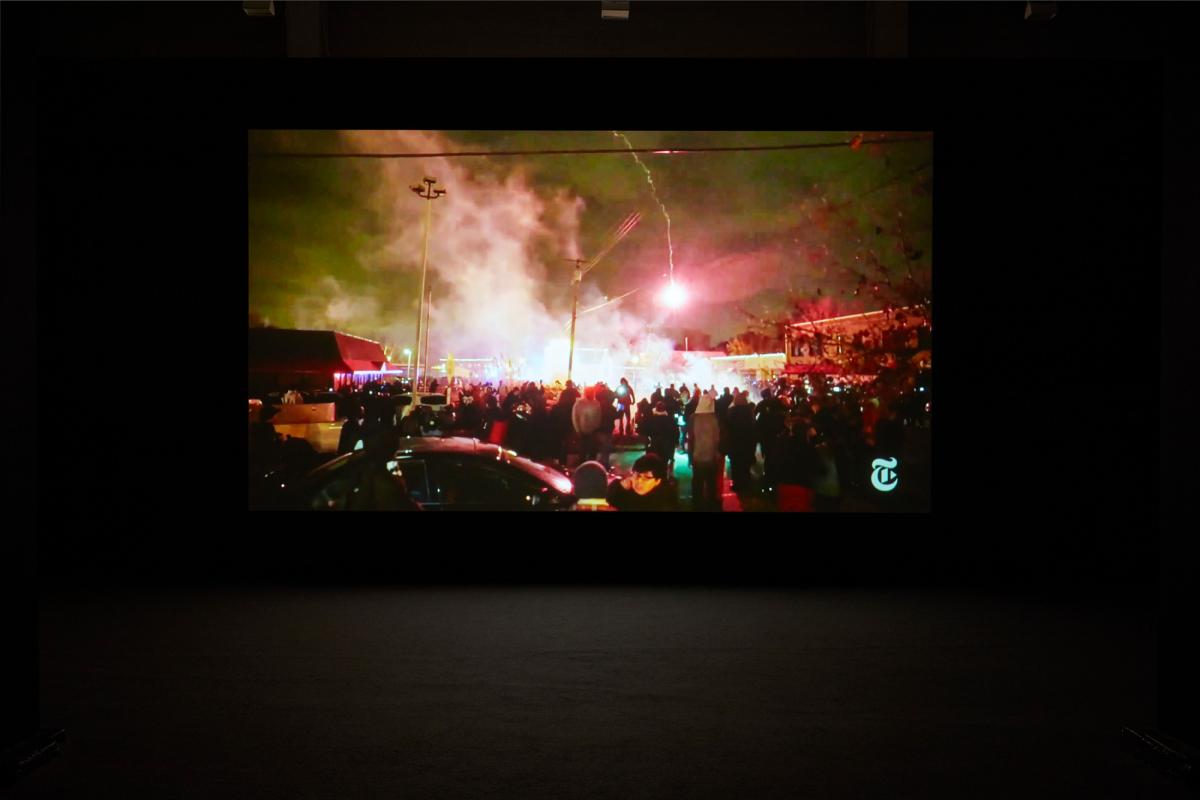
At SAAM, we want to be a museum for all. In times of national turmoil, this desire to be a space for all people needs to be realized in actions. Last month, we partnered with the Hirshhorn Museum and Sculpture Garden to stream artist Arthur Jafa’s Love is the Message, The Message is Death on our websites for 48 hours beginning Friday, June 26. The video, created in 2016, offers a powerfully moving montage of original and appropriated footage that speaks to our country’s current reckoning in response to ongoing police brutality and violence against Black people.To be a museum for all we need to provide space for community dialogue around these traumatic lived experiences. Thus, this blog highlights voices within our local community – specifically Black and people of color in the arts and creative community. We want to say thank you to these individuals who generously donated their time and intellect to reflect on Jafa’s art, but also on the greater sense of racial injustices experienced across the country. We will continue to work towards being a museum for all.
We will continue to work towards being a museum that addresses racial injustices both within our own behaviors and within our country. For this moment, we are proud to amplify these voices in our community and reflect on the breadth of lived experiences of Black Americans.
This is the first of two blog posts dedicated to reflections from our community.
All content remains the intellectual property of each contributor, and the responses have not been edited to maintain each individual's voice and style. On Thursday, July 9, at 3 p.m. ET, join us online for a curator-led conversation about Arthur Jafa’s powerful video with curators from SAAM and the Smithsonian's National Museum of African American History and Culture; registration required.
Ahmari Benton
Media outlets often contextualize and judge blackness by its proximity to whiteness, so it is refreshing to see black people authentically represented and honored. Jafa created a kaleidoscope of blackness with Love is the Message that captures so many of the nuances and layers of the black experience in America. Normalizing expressions of blackness in all forms is imperative as we continue to identify and dismantle white supremacy in our society.
Jafa’s work dissolves the myth that there is only one way to be black, while also highlighting the police brutality and respectability politics that have influenced black America’s cultural identity. Waking up black in this country can be fatal, and black artists have been screaming at America to acknowledge this core fact of our existence for generations. I hope that this summer of unrest will be a firm step towards collectively demanding aggressive accountability for the accumulating disappearances and murders of black folks across the country.
—Ahmari Benton, She/Her, Black Artists of DC
Wesley Clark
After watching Love is the Message, The Message is Death, I'm left spinning in a whirlwind of thought and wanting. I want more again and again. I'm drawn to it knowing I want to shield myself at certain parts. This piece is piercingly poignant; wholly encompassing the complexity of The African American Experience in an intoxicating seven-and-a-half-minute emotional roller coaster. At a time where there are attempts, in the society at large, to acknowledge and understand what we, Black Americans, have gone/are going through, Jafa serves up a storm; fluidly contrasting the multiple natures of a people — the harsh, brutally trauma-tainted, and beautifully spirited joy of the innovators / cultural avant-garde of this American society.
—Wesley Clark, artist
Jessica Stafford Davis
I first viewed Love is the Message, The Message is Death by Arthur Jafa, four years ago, and I had a visceral response – mouth dry, body sweating, stomach flipping, and tears. It triggered me as a Black woman and mom. My sons and I watched it together this past weekend - my eldest, 15 said he was numb and my youngest 12, said he was scared. I stand as a Black woman resolved to do whatever it takes to make sure mine and all Black children no longer have to live in fear or be marginalized and know they are beautiful, powerful, safe and worthy.
—Jessica Stafford Davis, founder of The Agora Culture and Art on the Vine
Carol Rhodes Dyson
In Love is the Message, The Message is Death, Arthur Jafa disrupts traditional western visual culture where sequential frames often indicate an easily readable and connected order. In this work, meaning and context can be disturbing and haunting, and is left up to the viewer.
Jafa assembles clips excavating the concept of blackness yet those images dwell on a cultural prowess in music, dance, sports and the church. Black figures of prominence in the video are musicians and sports figures as well as the requisite image of Martin Luther King, Jr. riding atop a convertible in a parade and one of President Obama in a Black church singing Amazing Grace.
Jelly legged and jelly butt folk seem to also play a significant role in the imagery as well as church folk “getting the Spirit.” Duality right? Sensuality and saved......
Effectively spliced in the presentation are images of police brutality and civil rights marches and water hosed protests. Another potent image was toward the end where the young boy was told to put his hands against the wall, as the police would tell him. And, the boy was crying because of the mistreatment.
My tendency is to look for the heroes, icons and triumphant narratives in black film and video work. Interesting to me, because he was NOT telling me what and how to think, I was encouraged to assess my own cultural experiences and knowledge, and assign them as victorious or not, over all odds.
The music by Kanye West did nothing to further enhance my understanding of the imagery or narrative. Perhaps it was my disgust of his politics that don’t allow me to go deep in his music. I know, it’s a generational thing. The other music was ok.
—Carol Rhodes Dyson, Curator, Busboys and Poets and Howard University Interdisciplinary Research Building
Omar Eaton-Martínez
This work was an explosion of tragedy and triumph expressed through black joy in the face of anti-blackness. It showed various proofs of the inhumanity of the dominant and the perseverance of the marginalized.
My heart broke when I saw the child slap his mother demanding that she wake up and the broken pieces of my heart sank when the father told his son that's "what the police do to you...put your hands up against the wall."
“Black life is not lived in the world that the world lives in, but it is lived underground, in outer space.” Jared Sexton, Professor of African American Studies at UC-Irvine.
Our forms of protest do not just exist in streets with megaphones, but also in our art, oral tradition, movement, fashion, literature and many forms of culture expression.
Farrakhan exposed American exceptionalism with a few words, “Oh now Mr. Wallace.”
—Omar Eaton-Martínez, Assistant Division Chief, Historic Resources, Natural and Historical Resource Division, M-NCPPC, Department of Parks and Recreation, Prince George’s County
Melvin Hardy
Quoting a passage in the video montage: "What would America be like if White people loved Black people as much as they love Black culture".
The multiple glimpses of the sun speak to the universality of cultural expression across the ethno-cultural spectrum of humanity. Black people's culture is but one, and should be honored and embraced as a mirror to all other cultural expression.
Jafa's work, amongst other things, speaks to the cultural appreciation, cultural appropriation, and cultural misappropriation of Black culture, this last action by the apparatus of state, through the oppressive annihilation of a people, their aspirations, and realization of their full humanity.
The matter of racialism, supremacy, anti-Blackness, terrorism, systemic oppression and inter-personal micro-oppressions, is presented in bold relief in this film.
I am left with hope for all of those of us laboring in the garden of social justice- seeking work, especially our museum community, in lifting Jafa's language into conversational currency and present discourse amongst Americans.
—Melvin Hardy, Millennium Arts Salon
Jaynelle Hazard
Arthur Jafa’s “Love is the Message, The Message is Death” is a spirit-filled, proclamation that leaves me with both a heavy heart and feelings of joy and comfort — a combination of emotions that has historically made up the Black experience. How brilliant for the Smithsonian American Art Museum, the Hirshhorn and the many participating museums to collaboratively pivot during a moment of transcendence and allow this work to be available outside of museum walls, making it accessible to a wider audience — the arts community, critical thinkers and the general public. I perceive Jafa’s intention as a call to the country and I walk away reminded of an excerpt from a Langston Hughes’ poem. “I am tired of waiting, aren’t you, for the world to become good and beautiful and kind?”
—Jaynelle Hazard, Executive Director & Curator, Greater Reston Arts Center
Martha Jackson Jarvis
Arthur Jafa “Love is the Message, The Message is Death”
Love ______ Death
Life
In between Love and Death is Life…Jafa eloquently describes it as “Everything”
It is a place/space where the verve and rhythms of African peoples reverberate around the globe, surviving tyranny, hate and malice to bring Light, Faith and culture to this living blue sphere floating in space. We dare to envision the rhythm of “Everything”… Yes, the message of the future is Love, but it can easily be Death, we must all decide which…Everything is Everything
Thank you Arthur Jafa for your work,
—Martha Jackson Jarvis, artist
Ellington Robinson
Love is the Message, The Message is Death (2016) is a simulated multi-dimensional masterpiece that captures the gravitational vicissitudes of the racist state that plagues this nation. Images of beauty and ugliness paint a high-low content, of visceral and nauseating survival and triumph, of us who “Matter.”
—Ellington Robinson, Painter and Mixed Media Artist
Schwanda Rountree
Arthur Jafa’s work is a true gift. The beauty and bitterness of it all makes you want to look away yet claim it at the same time. The essence of blackness. His work can leave a pit in your stomach in one instance and joy and pride in your heart in the next instance. The beauty and complex nature of Black. It is all ours (black people).
—Schwanda Rountree, attorney and art advisor





















